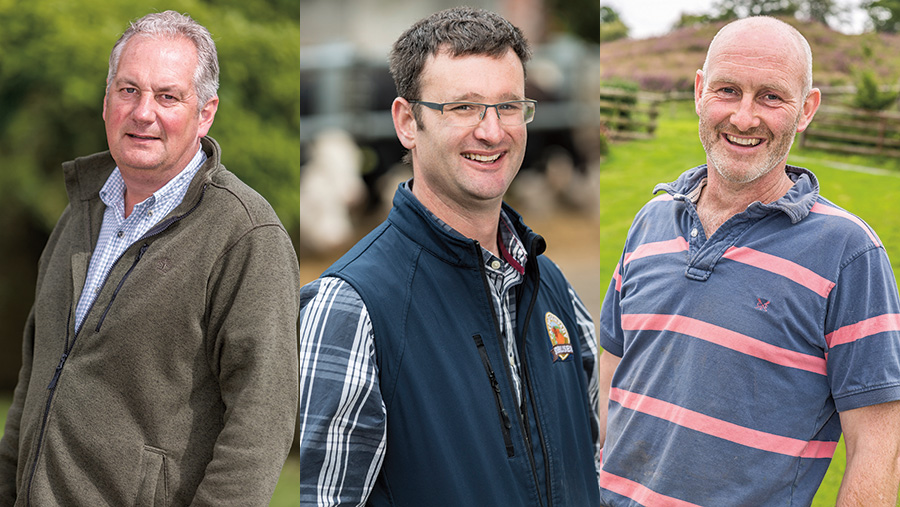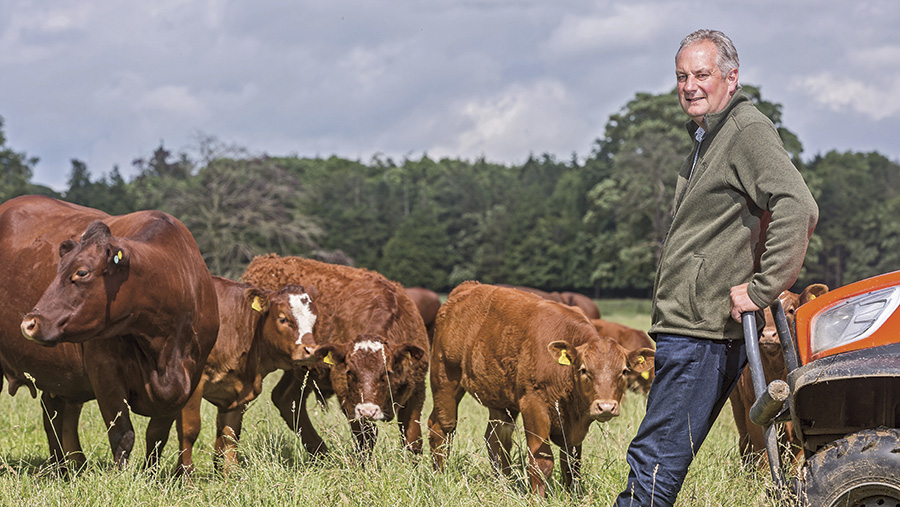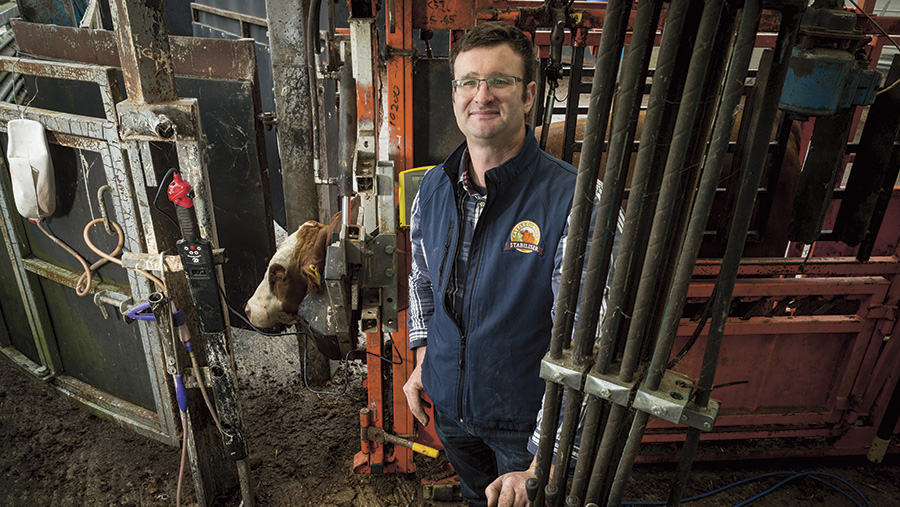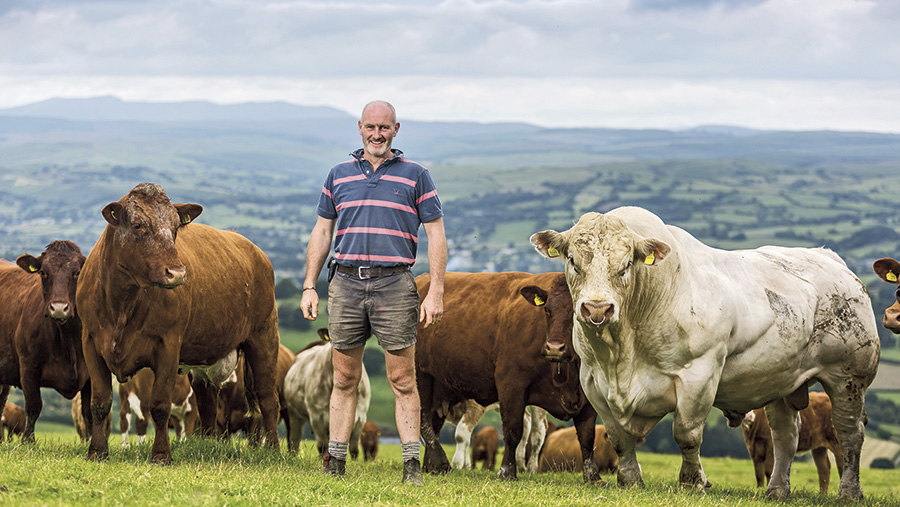2016 Farmers Weekly Awards: Beef Farmer of the Year finalists revealed
The Farmers Weekly Awards celebrate the very best of British farming by recognising and rewarding innovation, hard work and passion for agriculture.
This years three finalists are each placing high emphasis on health, performance and their customers to maximise profitability and improve business security. Rhian Price profiles the finalists.

From left: Peter Brown, Doug Dear and Richard Tudor
See also: Keep up with the latest from the 2016 Farmers Weekly Awards
Peter Brown
Park Farm, Middleton Stoney, Bicester, Oxfordshire

Peter Brown © Richard Stanton
Mixed farmer Peter Brown has created a three-way-cross suckler cow that dovetails perfectly with other farm enterprises at Park Farm, Bicester, Oxfordshire.
Since moving to his wife Jane’s family farm 26 years ago, he has switched the farms’ autumn- and spring-calving herd to a spring-calving block and has transformed the beef enterprise.
The judges liked
Three-way cross-breeding programme promoting hybrid vigour
Strong focus on maternal traits
Closed herd to enhance health, with heifers calving at two
Excellent integration of farm enterprises
Terminal sires selected on estimated breeding values
In place of the Hereford-cross-Friesian herd there now resides a low-cost, Simmental-cross-Sussex cow able to thrive on the farm’s 93ha of ancient parkland.
“The Hereford crosses were getting difficult to find in places where there wasn’t TB.
“I looked at native breeds because they’re cheaper to keep.
“To make the best use of the parkland we wanted to stock it with a suckler cow and the most efficient way to do it was to go all spring calving,” he explains.
Peter now runs a nucleus herd of 50 pure Sussex cows to produce replacements every year, which enables him to maintain a high health, closed herd.
These are then crossed with a Simmental bull, chosen for his calving ease and maternal estimated breeding values (EBVs), to make up the main herd of 120 cross-bred cows.
This main herd is then crossed to an Aberdeen Angus to produce finished cattle for Dovecote Park.
Peter believes the Simmental cross Sussex is the perfect cross, with each breed combining to create docile, milky, and medium-sized cows, which on average are lasting nine lactations.
Farm facts
1,250ha, which includes 1,084ha of arable
350 sow breeding/finisher herd
Simmental cross Sussex cows put to an Angus bull
Low replacement rates of 14%
High health status – closed herd and vaccinating for leptospirosis and bovine viral diarrhoea
The merits of his breeding programme are clear to see.
For the past three years he weaned 89 calves per 100 cows put to the bull and 98% of the herd calve unassisted.
Part of this is a result of Peter’s strict stance on underperforming animals, with cows culled for mastitis and lameness or poor feet and legs and bad fertility.
Heifers are selected for weight – they must have reached 350kg by 12 months – and conformation, and calve at two to maximise lifetime production.
Bulls must have a high health status with a greater focus placed on Aberdeen Angus bulls within the top percentile for 200-day and 400-day growth rates to maximise growth rates from forage.
Peter is transferring knowledge from the pig enterprise to reduce feed waste by feeding different group rations.
Once housed, cows get fed a grass-based TMR ration to target a condition score of 3.0 six weeks pre-calving, and after this a maintenance ration is fed to prevent calving problems.
Cows calve indoors in February over a compact 12-week calving period.
“As calves are born over a short period we can feed accurately at the growing and finishing stage, which has improved performance,” says Peter, who adds it also helps them to fill a lorry once cattle are fit.
Once calved, cows are transitioned on to a lactating ration until turnout in the spring, grass growth permitting.
A combination of pig and beef manure is applied to grassland, and because it is high quality this has reduced the amount of nitrogen spread to 150kg.
“We haven’t bought any P and K for 10 years and the soil indices is still good,” adds Peter, who soil samples regularly.
More recently he has been including grass leys in the arable rotation to effectively control blackgrass.
Calves are weaned at housing when they are six to eight months old, with average weaning weights hitting 348kg, off grass and milk alone.
At housing, the weaned calves are fed a grower ration of home-grown forage consisting of grass and maize silage with rapeseed meal.
Heifers are achieving growth rates of 1kg/day, while steers average 1.2kg.
Some heifers subsequently finish off grass and those that don’t are housed with the steers and fed a finisher ration with more maize silage to reach slaughter under two years, with Angus heifers and steers typically hitting 313kg carcass weight.
Peter is receiving a premium by selling all animals to Dovecote Park’s Aberdeen Angus scheme.
Meanwhile, Simmental-cross steers are sold through their British Beef scheme.
“The Angus scheme has worked well for us because what we lose in weight compared to the continental scheme is more than made up by the premium with minimal calving problems,” explains Peter.
Doug Dear
Osgodby Grange Farm, Osgodby, Selby, North Yorkshire

Doug Dear © Jim Varney
Price volatility and difficulty sourcing the right type of
animals at a competitive price led Doug Dear to set up a pioneering contract finishing enterprise.
Formerly he had a stint buying and finishing cross-bred bulls, but he says the enterprise tied up huge amounts of capital and offered very little financial reward.
He has wrestled bargaining power and improved business
security by setting up a robust and resilient bed and breakfast finishing service.
Currently, 1,500 cattle are put through the yard annually for a growing customer base of 18 farmers, with all cattle sold direct to Morrisons and some sold to Dovecote more recently.
The judges liked
Customer liaison – providing monthly feedback to cattle owners
Excellent use of technology to benchmark performance
Outstanding health protocols
State-of-the-art handling facility to reduce risk
Pioneer – created a low-risk, retained-ownership beef operation
“The idea was that we would farm owner-retained cattle because we would not have to buy the cattle and Morrisons would have continuity of supply.
“We’ve had a lot of help from David Evans, head of agriculture, to move the idea forward,” explains Doug.
Typically, cattle arrive at seven months old weighing 350kg liveweight and the aim is to take young bulls up to 370kg deadweight within 12-14 months of age and hit carcass specifications of R4L.
Stabilisers account for a large proportion of breeds catered for, with Doug providing the Stabiliser society with vital performance statistics, which are fed back into their breeding programme.
Older bulls and steers are also taken in for a sharp 90-day finish.
To achieve a fast turnaround, a great emphasis is placed on animal health.
Doug has developed health protocols so that animals get off to a flying start from the moment they touch down at the unit.
Two weeks before arrival, animals are vaccinated against respiratory syncytial virus, parainfluenza 3, pasteurella and infectious bovine rhinotracheitis, and on arrival they are weighed, treated for worms and fluke, and have their backs clipped out.
Owners are charged a daily finishing cost that covers straw, water, labour and repairs and renewals.
Farm facts
Contract finishing 1,500 cattle a year
Owns 304ha, rents 40ha and contracts a further 40ha
Grows wheat, barley, forage maize, sugar beet and oilseed rape
In the Higher Level Stewardship scheme
Founder member of the AHDB progressive beef group
Feed is charged on top of this, and is based on the dry matter intake of groups of animals each day, with information recorded through a Keenan feeder wagon, which is fitted with Pace technology to provide real-time information on feed conversion ratios.
To keep daily feeding routines simple, cattle are fed to appetite once a day, and Doug carries out daily feed trough scores to assess if rations need adjusting.
The aim is for just crumbs to be left in the trough and any leftover feed is scraped daily to avoid spoilage.
It is this attention to detail that is enabling Doug to achieve superb average daily liveweight gains of 1.8kg.
Complete transparency and trust are two founding business principles, and every month Doug’s wife Pam – who has been pivotal to the business’ success – provides each customer with data on individual cattle performance with their monthly invoice.
“A lot of animals are sold as stores and the breeder loses touch with the animals and so they don’t have access on how those animals finish,” points out Doug, who has sought to overcome this.
Measuring and monitoring every ounce of data is key to bridging this gap between breeder and finisher.
Each animal is fitted with an EID tag and Doug has built a state-of-the-art handling system to facilitate monthly weighing to track animal progress.
This allows Doug to consistently challenge performance and look at ways he can align the breeding unit with his own business to push performance.
Doug’s arable and beef enterprises dovetail nicely, with cereal sold to the beef enterprise for feed, but to further add value he has recently installed a grain dryercapable of drying 25t/hour and plans to contract dry and store grain for local farmers to maximise its use.
The couple also rent out land for a 55kW turbine and to help lower energy bills they purchase the electricity produced at a reduced rate.
Doug is constantly looking at ways to tighten business security, and with TB a constant threat and the introduction of post-movement tests earlier this year, he is now in the process of applying to become a licensed finishing unit to further minimise risks to his business.
They are also looking at ways they can mimic efficiencies from Pam’s family pig-finishing unit to improve feed-conversion rates and have recently conducted a carbon footprint assessment to highlight areas for improvement.
Richard Tudor
Llysun Farm, Llanerfyl, Welshpool, Powys

Richard Tudor © Richard Stanton
Richard Tudor is a shining example of how to operate a profitable upland beef enterprise.
He is making the most of every morsel of land for his spring-calving, 140-cow suckler herd to generate outstanding gross margins of £704 a cow – £100 above the best Welsh upland farms on average.
The judges liked
Outstanding grassland management
Exceptional calf growth rates
Strong focus on herd fertility enabling the herd to achieve incredible conception rates
Calving heifers at two and carrying out pelvic measurements
Using high-scoring estimated breeding value bulls
Having grown the business by almost 200ha since returning home after graduating from Aberystwyth University in 1998, Richard has placed a strong focus on herd fertility and is perfecting his breeding programme to develop a medium-sized cow that will thrive in upland conditions.
The original herd of Welsh Blacks has been slowly transitioned into a 140-cow herd of Simmental cross Saler cows, but recognising his cows’ mature size was getting too big for his upland farm, Richard has more recently introduced an Angus.
Saler heifers are put to an Angus bull to breed replacements. Half of the main herd is crossed to a high-index, terminal-sire Charolais bull within the top 5% of the breed for 200-day weights, while bigger, Simmental-type cows are put to a Saler.
Richard believes fertility is key to enhancing calf performance.
“I am trying to increase my conception rates because that’s the easiest way to increase my weaning weights,” says Richard, who adds that tightening his calving pattern also means it’s easier to group calves for sale.
Through his strong focus on fertility and rigorous breeding checks, Richard is achieving unbelievable conception rates, with 75% of the herd calving in the first three weeks of the calving period and 90% in six weeks, which he says is vital to his store selling enterprise.
In order to make it into the herd, heifers must be born from cows that calved in the first cycle.
They undergo pelvic area measurements and get fertility scored ahead of service in January when they are synchronised and AI’d to an American Angus, chosen for its short gestation length, daughter’s milking ability and structural soundness.
Farm facts
290ha upland farm plus 20ha rented
140 spring-calving cows plus 1,200 ewes and 300 lambs
High health status – bovine viral diarrhoea accredited and infectious bovine rhinotracheitis negative
Texel-cross lambs finished off on grass and sold to Waitrose
98% of calves born alive a cow scanned
A strong team of bulls is used in the main herd, with cows run in groups of 25 a bull in the first cycle to maximise first-service conception rates, before being mobbed into larger groups of 50 in the second.
All bulls are subject to annual semen tests.
This approach to maximising herd fertility, combined with Richard’s focus on high 200-day weight estimated breeding values (EBVs), is contributing to phenomenal calf performance, with April-born steers and heifers averaging daily liveweight gains of 1.53kg up to weaning.
This figure is even more impressive when you consider calves are fed a forage-based diet alone up to weaning in October, when cows are housed in cubicles and calves have access to creep and good-quality silage.
The aim is to sell steers and heifers as 10- and 18-month-old stores at Welshpool market in February and October, although 10% – those he isn’t happy to sell as stores – are sold direct to ABP, averaging 348kg carcass weights.
Richard says selling stores enables him to keep feed costs low by reducing the amount of purchase feed required.
This is further helped by his attention to detail when it comes to grassland management.
To make the best use of his poorer-quality hill ground, where land rises to 425m, annual soil sampling is carried out and he
rotational grazes mixed stock.
“On the hill ground, the aim is to keep the pH, K and P right and the cattle manage the grass,” explains Richard.
More recently, a further 20ha has been acquired on a five-year agreement at a competitive rent and this has been sown with a hybrid mix of plantain, grass, kale and rape for winter-grazing sheep.
About 20ha is reseeded annually and on lower-lying ground Richard is using a mixture of herbal grass leys and plantain.
Meanwhile, high-sugar grass and white clover varieties are grown to make high-energy silage for the winter.
This year Richard’s became the first farm in the UK to grow Fixation – a high protein and deep-rooting clover variety that originates from Oregon, US – which he is trialling as part of his role as a demonstration farm for Farming Connect.
As well as this, Richard sits on the NFU Welsh livestock board and the Hybu Cig Cymru research and development committee.
The Farmers Weekly Beef Farmer of the Year 2016 award is sponsored McDonald’s.
 “The sustainability of the beef industry is crucial to a business such as ours, and these finalists show how attention to detail in management and a focus on the end customer can deliver that sustainability”
“The sustainability of the beef industry is crucial to a business such as ours, and these finalists show how attention to detail in management and a focus on the end customer can deliver that sustainability”
Connor McVeigh
McDonald’s supply chain director
